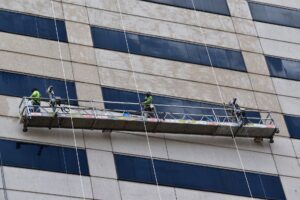There are many different types of scaffolding, from cantilever, putlog to bamboo scaffolding. Scaffolding is one of the most commonly used pieces of construction equipment used in the industry. The type of scaffolding will depend on the purpose of the scaffolding. Suspended scaffolding is a special type of scaffolding that is used under certain conditions. This article will discuss what suspended scaffolding is and what types of suspended scaffolding there is.
Firstly, what is suspended scaffolding?

Suspended scaffolding is a temporary lifting mechanism system and is also referred to as a hanging working platform. Suspended scaffolding is a modern and highly efficient overhead operation equipment and is often used as a replacement for traditional scaffolding.
Suspended scaffolding is essential when work needs to be completed at a height and it is not possible to erect scaffolding from the ground. It offers easy access to medium-height buildings to skyscrapers and is often used for working on high-rise building facades. It works by leaning against the walls of the building.
Examples of where you could find suspended scaffolding include outer wall construction, curtain wall installation, outer wall cleaning and maintenance of high rise buildings. You may also find suspended scaffolding being applied to large tanks, bridges, dams and other engineering structures.
What are the types of suspended scaffolding?
Catenary
The working platform is supported by two horizontal and parallel ropes. These ropes are attached to structural components of a building or other structure.
Float
A float is a type of suspended scaffolding that has one braced platform resting on two parallel bearers. It is hung from overhead supports by ropes.
Interior Hunt
The platform of this type of suspended scaffolding is suspended from a roof structure.
Needle Beam
The platform is suspended from needle beams and attached on one end to the permanent structure.
Single-point adjustable
An overhead support allows the platform to be suspended. This is most commonly used for window cleaning of high-rise buildings.
Two-point (swing stage)
This is the most commonly used suspended scaffolding. It is hung by ropes or cables that are connected to the stirrups at the end of the platform. The reason for its popularity as a suspended scaffolding type is that it has wide application at different sites. It can be used for high building external wall cleaning, construction decoration and for welding at different working heights.
Multi-point Adjustable
The platform is hung at multiple points and ropes from overhead supports.
Multi-level
Two-point or multi-point suspended platform with a series of platforms at multiple levels.
Advantages of Suspended Scaffolding
When it is used in the right applications, suspended scaffolding has many benefits over other types of scaffolding:
-
- Lightweight, easy to assemble and disassemble.
- It needs less materials to reach greater heights as others need to be built from the ground up.
- It requires fewer parts which means it is more portable and easier to store.
- It can be customised to suit the applications needs.
- When using a motorised hoist system, it allows for highly efficient workflows.
- It is a very cost effective alternative to traditional scaffolding systems.
Disadvantages of Suspended Scaffolding
- Suspended scaffolding is only really justifiable for high rise buildings.
- It cannot be used to carry out heaving construction operations.
- Restrictions on high loading.
- Low surface coverage in the horizontal direction.
Safeway Scaffolding
Safeway Scaffolding is one of the largest-established scaffolding companies in the Midlands. We specialise in the supply and erection of scaffolding to a range of industries. If you are looking for commercial, domestic or bespoke scaffolding in the Midlands, Safeway Scaffolding is a reliable and professional specialist. To get in touch, contact us on 01675 465 593 or through filling out our online contact form.
